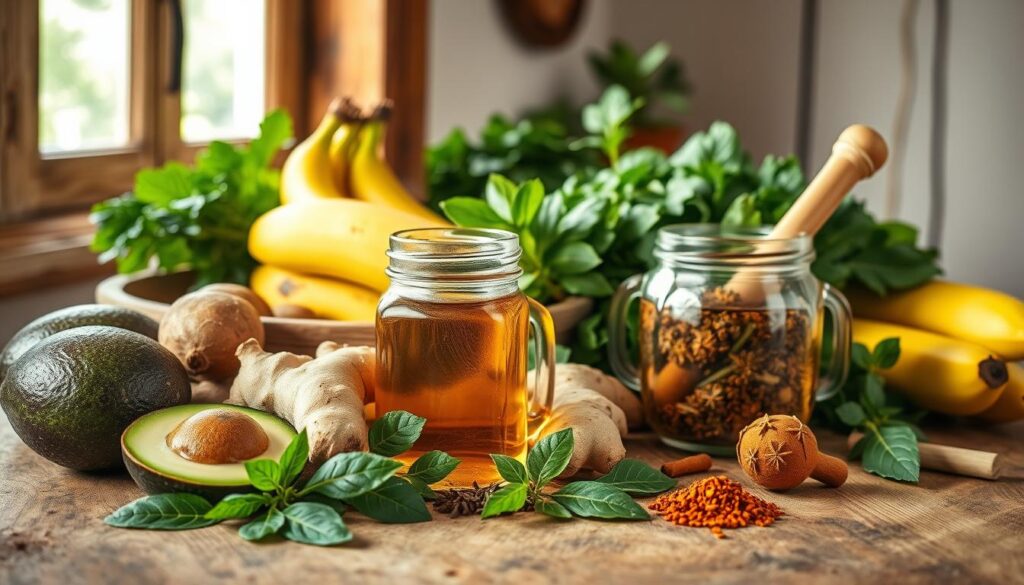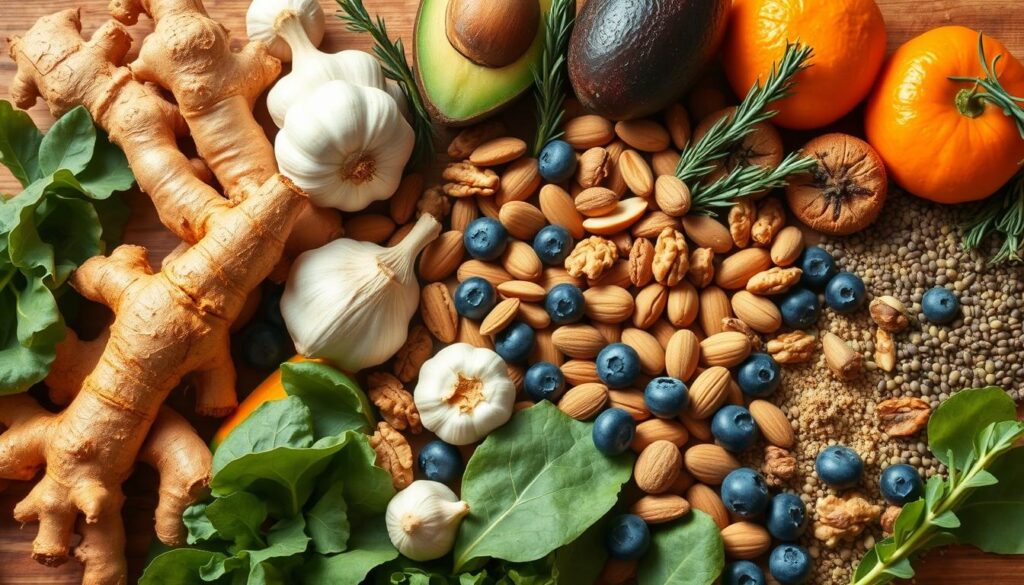Anúncios
Headaches can be debilitating, affecting daily life and productivity. While there are various treatments available, incorporating natural remedies into your diet can play a significant role in headache relief.
Certain food triggers can exacerbate headache symptoms, but consuming the right foods can help alleviate them. By making informed dietary choices, individuals can better manage their headaches and improve overall well-being.
Anúncios
Key Takeaways
- Understanding the role of diet in headache management
- Identifying common food triggers for headaches
- Incorporating natural remedies into your diet for headache relief
- Making informed dietary choices to alleviate headache symptoms
- Improving overall well-being through dietary changes

Natural Foods to Relieve Headaches
Understanding Different Types of Headaches
Headaches are a common health issue that affects millions of people worldwide, and understanding their types is crucial for effective management. Headaches can be broadly classified into several types, each with its unique characteristics and symptoms.
Tension Headaches
Tension headaches are the most common type, often described as a band or a squeezing sensation around the forehead. They are usually caused by muscle tension in the neck and scalp, often triggered by stress, poor posture, or fatigue.
Migraines
Migraines are severe headaches characterized by throbbing pain, typically on one side of the head. They are often accompanied by nausea, vomiting, and sensitivity to light and sound. Migraines can be triggered by hormonal changes, certain foods, or sensory stimuli.
Cluster Headaches
Cluster headaches are rare but extremely painful, occurring in clusters or cycles. They are characterized by severe, one-sided pain, often accompanied by tearing of the eye and nasal congestion. The exact cause of cluster headaches is unknown, but they are believed to be related to abnormalities in the body’s internal clock.
Sinus Headaches
Sinus headaches are caused by inflammation or infection in the sinuses, leading to pain and pressure in the face, cheeks, and forehead. They are often accompanied by nasal congestion, fever, and discharge.
| Type of Headache | Characteristics | Common Triggers |
|---|---|---|
| Tension Headache | Band-like pressure around the forehead | Stress, poor posture, fatigue |
| Migraine | Throbbing pain, usually one-sided | Hormonal changes, certain foods, sensory stimuli |
| Cluster Headache | Severe, one-sided pain | Unknown, possibly related to internal clock abnormalities |
| Sinus Headache | Pain and pressure in the face and forehead | Sinus inflammation or infection |
Understanding the different types of headaches is the first step towards finding effective relief. By identifying the specific type of headache and its triggers, individuals can make informed decisions about their treatment and lifestyle changes.
The Connection Between Diet and Headaches
The connection between diet and headaches is an area of growing interest, with research highlighting the impact of nutrition on headache frequency and severity. Understanding how dietary choices influence headache occurrence can empower individuals to make informed decisions about their diet.
How Food Affects Brain Chemistry
Certain foods contain compounds that can affect brain chemistry, potentially triggering or relieving headaches. For instance, foods rich in magnesium can help relax blood vessels and alleviate headache symptoms. On the other hand, foods high in tyramine, such as aged cheeses, can trigger headaches in some individuals.
Inflammation and Pain Response
Dietary choices can also influence inflammation and pain response in the body. Consuming foods high in omega-3 fatty acids, such as salmon, can help reduce inflammation, while foods high in sugar and refined carbohydrates may exacerbate it.
Dehydration and Headache Triggers
Dehydration is a common headache trigger, and diet plays a crucial role in maintaining hydration levels. Foods with high water content, such as watermelon and cucumbers, can contribute to daily hydration needs.
| Food Group | Examples | Effect on Headaches |
|---|---|---|
| Magnesium-rich foods | Dark leafy greens, nuts, seeds | Relieves headache symptoms |
| Omega-3 rich foods | Salmon, sardines, walnuts | Reduces inflammation |
| Hydrating foods | Watermelon, cucumbers, celery | Prevents dehydration |
Natural Foods that Relieve Headaches

Nature offers a variety of foods that can help mitigate headache pain. Incorporating these foods into your diet can be a natural and effective way to manage headache symptoms.
Overview of Food-Based Remedies
Food-based remedies for headaches include a range of natural foods that have been traditionally used to alleviate pain. These foods work by addressing the underlying causes of headaches, such as inflammation, dehydration, and nutrient deficiencies.
Some of the most effective food-based remedies include ginger, which has anti-inflammatory properties, and magnesium-rich foods like dark leafy greens, which can help relax blood vessels and improve blood flow.
Scientific Evidence for Food Treatments
Research has shown that certain foods can have a significant impact on headache relief. For example, studies have found that ginger has anti-inflammatory compounds that can help reduce pain and inflammation.
| Food | Benefit |
|---|---|
| Ginger | Anti-inflammatory properties |
| Dark Leafy Greens | Magnesium content for blood vessel relaxation |
| Fatty Fish | Omega-3 fatty acids for inflammation reduction |
How Quickly Foods Can Provide Relief
The speed at which foods can provide headache relief varies depending on the individual and the specific food consumed. However, many people report experiencing relief within a few hours of consuming headache-relieving foods.
For instance, ginger tea can start to take effect within 30 minutes to an hour, providing quick relief from headache symptoms.
Hydrating Foods for Headache Prevention
Staying hydrated is crucial for preventing headaches, and incorporating hydrating foods into your diet can make a significant difference. Dehydration is a common headache trigger, and consuming foods with high water content can help maintain the body’s fluid balance.
Watermelon and Cucumber
Watermelon and cucumber are two of the most hydrating foods available. Watermelon is composed of about 92% water, making it an excellent choice for hydration. Cucumber is also highly effective, with a water content of around 96%. Both can be easily incorporated into salads, smoothies, or enjoyed as snacks.
Coconut Water
Coconut water is a natural source of electrolytes, including potassium, which helps regulate fluid balance in the body. It’s an excellent beverage for replenishing lost fluids and can be consumed on its own or used in various recipes.
Celery and Lettuce
Celery and lettuce are other hydrating options. Celery is made up of about 95% water and can be a crunchy addition to meals or a snack on its own. Lettuce, with its high water content, is a versatile ingredient for salads and sandwiches.
Broths and Clear Soups
Broths and clear soups are not only hydrating but also provide essential salts and minerals. They can be particularly beneficial when you’re feeling unwell or need a gentle, easily digestible meal option.
Magnesium-Rich Foods to Ease Pain
Incorporating magnesium-rich foods into your diet can be a natural way to alleviate headache pain. Magnesium plays a crucial role in various bodily functions, including muscle relaxation and nerve function, which can help mitigate headache symptoms.
Magnesium deficiency is often linked to headaches, making it essential to consume foods rich in this mineral. Some of the top magnesium-rich foods include:
Dark Leafy Greens
Dark leafy greens like spinach, kale, and Swiss chard are packed with magnesium. Adding these greens to salads, smoothies, or sautéing them as a side dish can significantly boost your magnesium intake.
Nuts and Seeds
Nuts and seeds, such as almonds, cashews, and pumpkin seeds, are not only rich in magnesium but also provide a healthy snack option. Enjoy them as a snack or add them to your meals for an extra magnesium kick.
Whole Grains
Whole grains, including brown rice, quinoa, and whole-wheat bread, are excellent sources of magnesium. Incorporating these into your meals can help maintain your magnesium levels.
Bananas and Avocados
Bananas and avocados are not only delicious but also rich in magnesium. Enjoy bananas as a quick snack or add sliced avocados to your salads and sandwiches.
By incorporating these magnesium-rich foods into your diet, you can help alleviate headache pain and improve your overall health. A balanced diet combined with a healthy lifestyle can make a significant difference in managing headache symptoms.
Anti-Inflammatory Foods for Headache Relief

Certain foods have potent anti-inflammatory properties that can help mitigate headache pain. Incorporating these foods into your diet can be a natural and effective way to manage headache symptoms.
Fatty Fish Rich in Omega-3s
Fatty fish such as salmon, mackerel, and sardines are rich in omega-3 fatty acids, which have powerful anti-inflammatory effects. Omega-3s can help reduce inflammation in the body, potentially alleviating headache symptoms.
Ginger and Turmeric
Ginger and turmeric are well-known for their anti-inflammatory properties. Ginger has been shown to reduce pain and inflammation, while turmeric contains curcumin, a compound with potent anti-inflammatory and antioxidant properties.
Berries and Cherries
Berries and cherries are rich in antioxidants and have anti-inflammatory effects. Consuming these fruits can help reduce oxidative stress and inflammation, potentially providing headache relief.
Olive Oil and Other Healthy Fats
Olive oil, rich in monounsaturated fats, has anti-inflammatory properties that can help reduce inflammation. Other healthy fats, such as those found in avocados and nuts, also contribute to an anti-inflammatory diet.
| Food | Anti-Inflammatory Compound | Potential Benefit |
|---|---|---|
| Fatty Fish | Omega-3s | Reduces inflammation |
| Ginger | Gingerol | Reduces pain and inflammation |
| Turmeric | Curcumin | Anti-inflammatory and antioxidant effects |
| Berries and Cherries | Antioxidants | Reduces oxidative stress and inflammation |
| Olive Oil | Monounsaturated fats | Reduces inflammation |
Foods Containing Essential Vitamins for Headache Prevention
Headache prevention can be supported by consuming foods rich in essential vitamins. A diet lacking in these vitamins may contribute to the frequency and severity of headaches. Incorporating foods rich in vitamins B2, D, E, and Coenzyme Q10 can be particularly beneficial.
Vitamin B2 (Riboflavin) Sources
Vitamin B2, or Riboflavin, has been shown to help reduce the frequency of migraines. Foods rich in Vitamin B2 include:
- Dairy products like milk and yogurt
- Leafy greens such as spinach and kale
- Nuts and seeds, particularly almonds and sunflower seeds
- Whole grains like brown rice and quinoa
Vitamin D Rich Foods
Vitamin D is important for overall health, and research suggests it may also play a role in headache prevention. You can find Vitamin D in:
- Fatty fish like salmon and mackerel
- Fortified dairy products and plant-based milk
- Eggs, particularly those from pasture-raised hens
Vitamin E for Circulation
Vitamin E is known for its antioxidant properties and its role in maintaining healthy circulation, which can help in preventing headaches. Rich sources include:
- Nuts and seeds, such as almonds and sunflower seeds
- Vegetable oils like wheat germ oil and sunflower oil
- Leafy greens and broccoli
Coenzyme Q10 in Foods
Coenzyme Q10 (CoQ10) is another nutrient that has been linked to reduced migraine frequency. It can be found in:
- Meat and poultry, especially organ meats like liver
- Fatty fish such as salmon and sardines
- Whole grains and nuts
By incorporating these vitamins and nutrients into your diet through whole foods, you can take a proactive approach to headache prevention. It’s always a good idea to consult with a healthcare professional before making significant changes to your diet.
Foods to Avoid That Trigger Headaches
Understanding the foods that trigger headaches is crucial for effective prevention. Certain dietary components can initiate or exacerbate headache symptoms, making it essential to identify and avoid these triggers.
Common Food Triggers
Some foods are more likely to trigger headaches due to their chemical composition. These include foods high in histamine, tyramine, and other vasoactive amines.
- Processed meats
- Certain types of cheese
- Chocolate
Processed Foods and Additives
Processed foods often contain additives and preservatives that can trigger headaches. Examples include:
- Monosodium glutamate (MSG)
- Artificial sweeteners like aspartame
- Nitrates and nitrites in processed meats
Being mindful of food labels can help individuals avoid these potential headache triggers.
Alcohol and Caffeine
Both alcohol and caffeine are well-known headache triggers. Alcohol can cause dehydration and contains histamine, while caffeine can lead to withdrawal headaches if consumed excessively or stopped abruptly.
| Trigger | Potential Effect |
|---|---|
| Alcohol | Dehydration, histamine release |
| Caffeine | Withdrawal headaches, vasoconstriction |
Aged and Fermented Products
Aged cheeses, fermented foods, and certain beverages contain tyramine and other compounds that can trigger headaches in susceptible individuals.
By being aware of these potential triggers and making informed dietary choices, individuals can reduce their likelihood of experiencing headaches.
Creating a Headache-Relief Meal Plan
Developing a meal plan that incorporates foods known to relieve headaches can be a game-changer for those suffering from frequent headaches. By focusing on nutrient-rich foods, individuals can help alleviate headache symptoms and improve overall well-being.
Breakfast Options
Starting the day with a nutritious breakfast can set a positive tone for headache management. Oatmeal with banana and nuts is a great option, as it combines complex carbohydrates with magnesium-rich foods. Alternatively, a spinach and feta omelette can provide a boost of magnesium and protein.
Lunch and Dinner Ideas
For lunch and dinner, incorporating fatty fish rich in omega-3s, such as salmon, can help reduce inflammation. Quinoa and vegetable stir-fries are also beneficial, offering a mix of complex carbohydrates and anti-inflammatory compounds.
Snacks and Smoothies
Healthy snacking is crucial for maintaining stable blood sugar levels and preventing dehydration. Magnesium-rich nuts like almonds and cashews make great snacks. A smoothie made with berries, banana, and almond milk can provide a quick and refreshing way to consume headache-fighting nutrients.
Sample 7-Day Meal Plan
A sample meal plan can help guide individuals in incorporating headache-relieving foods into their diet. Here’s a basic outline:
- Monday: Oatmeal with banana and nuts for breakfast, grilled salmon for dinner
- Tuesday: Spinach and feta omelette for breakfast, quinoa and vegetable stir-fry for lunch
- Wednesday: Smoothie bowl with berries and almond milk for breakfast, turkey and avocado wrap for lunch
- Thursday: Whole grain toast with almond butter for breakfast, lentil soup for dinner
- Friday: Greek yogurt with honey and walnuts for breakfast, grilled chicken with roasted vegetables for dinner
- Saturday: Avocado toast on whole grain bread for breakfast, fatty fish with quinoa for dinner
- Sunday: Breakfast burrito with scrambled eggs and black beans, grilled turkey burger for lunch
Quick Relief Recipes
For immediate relief, a ginger and turmeric tea can be very effective. Simply steep fresh ginger and turmeric in hot water, then strain and enjoy.
Preventative Meal Combinations
Combining foods that are rich in magnesium, omega-3 fatty acids, and antioxidants can help prevent headaches. A salad with spinach, walnuts, and olive oil dressing is a nutritious and preventative meal option.
Conclusion: Integrating Headache-Fighting Foods Into Your Lifestyle
Incorporating headache-fighting foods into your diet can be a powerful step towards managing headaches. By understanding the types of headaches and how diet affects them, you can make informed choices about the foods you eat.
Making lifestyle changes such as adopting a balanced diet rich in headache-fighting foods can help alleviate headache symptoms. Foods high in magnesium, anti-inflammatory compounds, and essential vitamins can play a crucial role in headache prevention.
Embracing natural remedies like hydrating foods, magnesium-rich foods, and anti-inflammatory foods can lead to significant improvements in headache management. It’s also important to identify and avoid common food triggers.
By creating a meal plan that incorporates these foods and avoiding triggers, you can take control of your headaches. Start by making small changes to your diet and observe how your body responds. With time and patience, you can develop a personalized approach to managing headaches through dietary changes.
FAQ
What are some natural foods that can help relieve headaches?
How does diet affect headaches?
What are some common food triggers that can cause headaches?
How can I incorporate headache-relieving foods into my diet?
Are there any specific vitamins or nutrients that can help prevent headaches?
Can certain foods provide quick relief from headaches?
How can I create a headache-relief meal plan?
What are some hydrating foods that can help prevent headaches?
How does magnesium help with headache relief?
Content created with the help of Artificial Intelligence.



